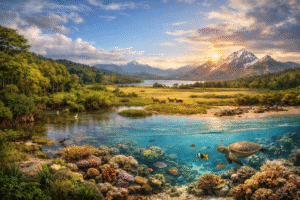Did you know? Drones can monitor wildlife in places humans can barely reach, helping save endangered species worldwide.
When you think about drones, your mind might go to sleek gadgets zipping through the sky, delivering packages, or filming epic travel shots. But did you know they’re revolutionizing wildlife conservation, too? From protecting vulnerable species to monitoring habitats, drones are becoming the unsung heroes of conservation efforts. Let’s dive into how these flying marvels are making a difference in ways you might not have imagined.
The Need for Innovative Wildlife Conservation
Wildlife conservation has always been a challenging endeavor. Traditional methods, such as ground surveys and manned aerial monitoring, are often time-consuming, expensive, and sometimes dangerous. In areas like dense rainforests, rugged mountain ranges, or vast savannahs, accessing wildlife habitats can be nearly impossible.
This is where drones, also known as Unmanned Aerial Vehicles (UAVs), come into play. Compact, versatile, and cost-effective, drones are reshaping how scientists and conservationists work.
How Drones are Being Used in Wildlife Conservation
Monitoring Endangered Species
Tracking endangered species like elephants, rhinos, and tigers is critical to understanding their movements and behaviors. Drones equipped with high-resolution cameras and thermal imaging can track these animals from the sky without disturbing them.
Example:
In Africa, drones have been used to monitor black rhinos in national parks. Traditional tracking requires physically tagging the animal, which can be stressful and invasive. Drones, however, can follow these majestic creatures from a safe distance, providing real-time data without harm.

Combatting Poaching
Illegal wildlife poaching has devastating effects on species like elephants and pangolins. Patrols on the ground can only cover so much area, but drones can monitor vast landscapes with precision. Many drones now come with AI (Artificial Intelligence) systems to detect unusual activity, such as groups of humans in restricted zones.
Case Study:
In India’s Kaziranga National Park, drones have been deployed to prevent poaching of the one-horned rhinoceros. By providing live feeds, they help rangers respond quickly to suspicious activities, saving countless animals.
Surveying Hard-to-Reach Habitats
Some ecosystems are too remote or dangerous for humans to explore. Whether it’s the dense Amazon rainforest or the icy tundras of the Arctic, drones can access these areas and collect valuable data.
Anecdote:
Scientists in Alaska used drones to study the movements of polar bears across melting ice sheets. The drones’ lightweight design allowed them to navigate these harsh conditions, capturing insights that would otherwise be impossible to gather.
Documenting and Mitigating Environmental Damage
Wildlife conservation isn’t just about protecting animals—it’s also about preserving their habitats. Drones help document deforestation, wildfires, and pollution, offering a bird’s-eye view of the damage and allowing quick interventions.
Real-World Impact:
During the Australian bushfires in 2019-2020, drones were instrumental in identifying affected wildlife zones. Conservationists used this data to guide rescue teams and prioritize areas for reforestation.
Assisting in Marine Conservation
Drones aren’t limited to land. Specialized aquatic drones can monitor marine life, track migration patterns, and even combat illegal fishing.
Example:
Ocean Alliance, a non-profit organization, uses drones to collect whale snot (yes, really!) to analyze the health of whale populations without requiring invasive techniques.
Engaging Communities in Conservation
Drones are not just for scientists. They’re also being used to educate and involve local communities. Many conservation organizations use drone footage to showcase the beauty of wildlife and emphasize the urgency of conservation efforts, inspiring collective action.
Challenges in Using Drones for Conservation
Of course, drones aren’t without their challenges. They can be expensive, require skilled operators, and sometimes disturb wildlife if not used responsibly. There’s also the issue of regulations—many countries have strict laws governing drone usage, especially in protected areas.
However, with advancements in technology and collaboration among governments, NGOs (Non-Governmental Organizations), and tech companies, these hurdles are gradually being overcome.
The Future of Drones in Conservation
The potential for drones in wildlife conservation is enormous. From integrating AI to predict animal behaviour to using solar-powered drones for longer flights, the possibilities are endless. With the right strategies, drones can help bridge the gap between human efforts and the vastness of nature.
Conclusion: Soaring Toward a Better Future
Drones are more than just tech toys—they’re tools of hope for wildlife conservation. By providing new ways to monitor, protect, and restore our natural world, they’re helping us build a more sustainable future.
Whether it’s the sight of a whale breaching the ocean surface or an elephant roaming freely in its habitat, drones remind us of what’s at stake. If you’ve ever been fascinated by the wonders of nature, now is the time to support innovative conservation methods like these.
Author’s Note
The next time you see a drone in action, think beyond the technology. Picture the countless lives it might be saving—from a black rhino in Africa to a polar bear in the Arctic. Let’s embrace innovation to protect our planet’s most precious inhabitants.
G.C., Ecosociosphere contributor.
References and Further Reading
- Drones for Wildlife Conservation – World Wildlife Fund (WWF)
- How Drones are Saving Endangered Species
- DRONES IN ENERGY PLANTS! – Amanos Drones. https://amanosdrones.com/en/drones-in-energy-plants/




